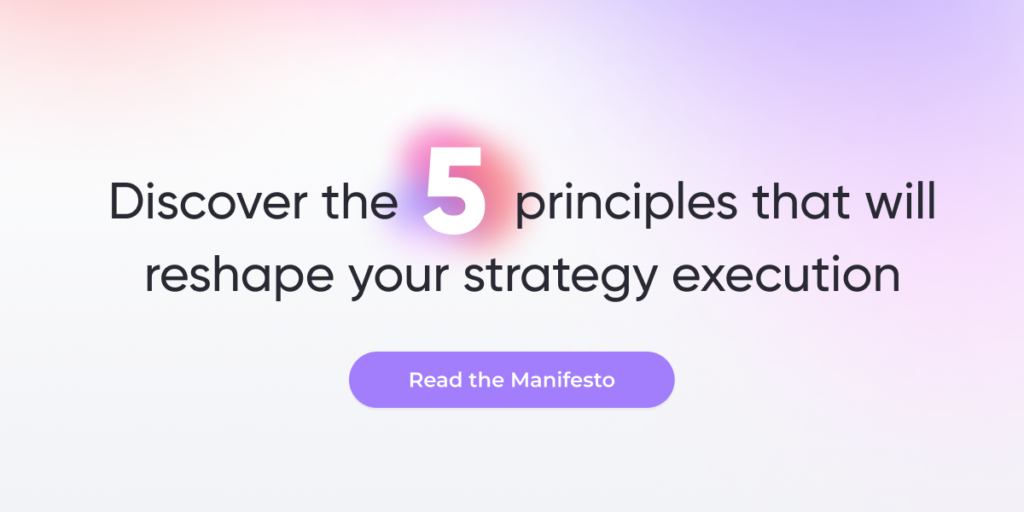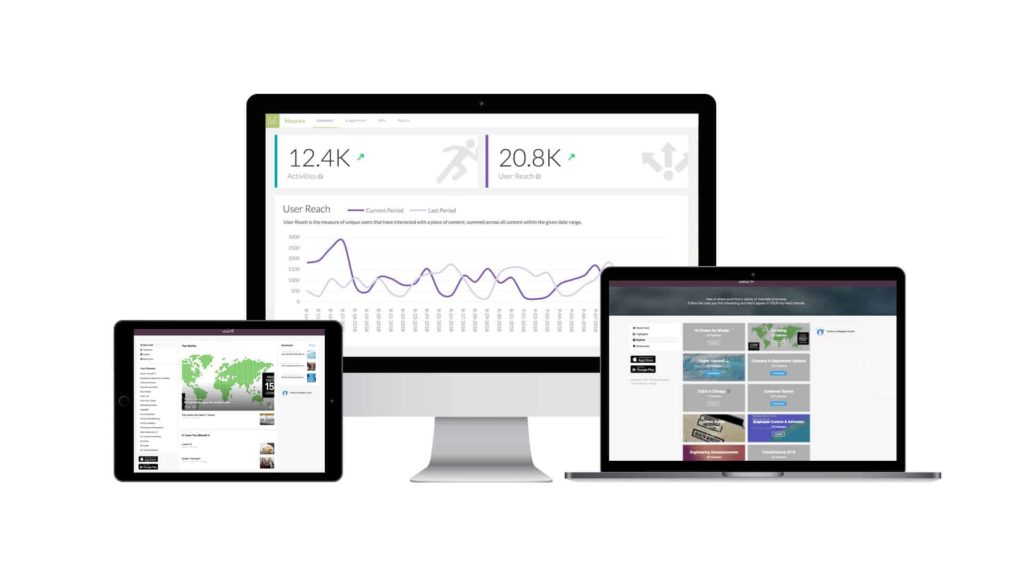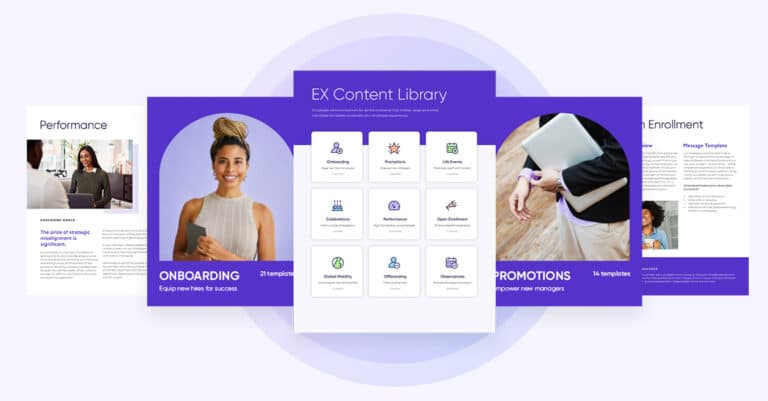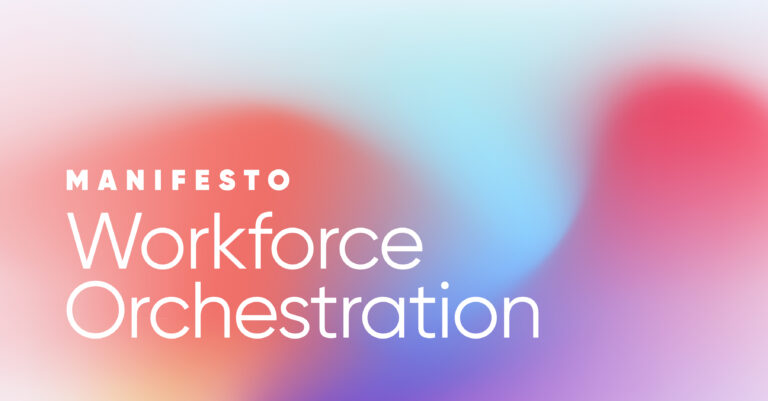Internal communications definition
Internal communication is a continuous process within an organization that keeps employees informed and connected using verbal, written, and digital channels. It promotes a shared understanding of company goals, values, and guidelines across departments. By establishing a clear, trusted voice, internal communication supports transparency and ensures everyone stays updated on the latest initiatives, enhancing the overall employee experience.
Let’s face it, today’s workforces don’t look like they used to. With the rise of technology tools, globalization, and the lasting impacts of recent global disruptions, internal communicators are now facing new and evolving challenges. Success in internal communications means reaching employees with hyper-personalized, timely messages that contribute to a positive employee experience, engagement, and productivity. On the other hand, ineffective communication strategies can leave employees feeling confused, unproductive, and disconnected from company initiatives.
In this post, we explore what internal communication means today, focusing on data-driven strategies and best practices to help you drive successful change in your organization.
Key Insights
- Internal communication today uses smart, data-driven strategies to send personalized messages that truly resonate with employees and align them with company goals.
- In 2025, employee communication relies on multi-channel tools to keep a dispersed workforce engaged, no matter where they are or how they prefer to connect.
- To deliver relevant, personalized content that boosts engagement, AI and data analytics have become game-changers for internal communications.
- An effective internal communications strategy doesn’t just inform—it actively aligns with business objectives, driving real employee engagement along the way.
- Internal communication has to be in lockstep with business strategy to make sure employees understand and feel empowered to support company initiatives.
- Data-driven platforms are key to optimizing employee communication by delivering the right message at the right time, on the channels employees prefer.
Internal communication trends for 2025

Let’s examine the two main factors impacting internal communications. One is the effect of technological change, and the other is the move towards a hybrid workforce. Both trends have far-reaching implications and may radically alter the workplace as we know it; at the same time, they also have the potential to render internal communications teams indispensable to achieving high levels of productivity and efficiency.
Deliver a hyper-personalized employee experience at scale
Impact of technology in the workplace
The sheer amount of technology affecting workplaces around the world is truly staggering. According to The World Economic Fund’s The Future of Jobs Report, companies surveyed plan to invest in new technologies as part of their growth strategy by 2027. The key technologies mentioned including:
- Big data analytics
- Cloud computing
- AI and machine learning
- Internet of Things and connected devices
- Encryption and cybersecurity
These tools make companies more efficient, expand their reach, and allow them to compete in a digital-first world. However, the challenge is ensuring employees remain engaged and aligned with organizational goals in the midst of rapid technological change. By using platforms that harness employee data, such as behavioral insights and preferences, internal communications teams can deliver hyper-personalized messages that ensure no one is left behind.
It’s estimated that 69 million new jobs may be created by 2027 due to the adoption of new technologies and digital transformation, while 83 million jobs may be displaced. This results in a net decrease of 14 million jobs, or 2% of current employment. To navigate this transition, communications leaders must embrace strategies that tailor messages to individual employees’ roles and journeys, making communication more relevant and impactful.
Now is the time to focus on the employee experience.
The success of any company initiative depends on whether employees can (and want to) meet strategic organizational objectives. This is especially true during an accelerated digital transformation. If most employees feel disconnected from the business and don’t understand why decisions are being made, the organization’s program is likely to fail. Good internal communications creates personalized, timely employee engagement , driving better outcomes. Strong, tailored communications provide a major strategic advantage.
Impact of freelance and gig economy workers
Advancements in technology have also fueled the rise of freelance and gig-economy workers. Internal communicators must know how to reach a growing, dispersed workforce, including deskless and frontline employees who make up 80% of the global workforce. Using data-driven tools to personalize communication ensures every employee understands company-wide business goals and stays engaged with relevant information.
Employee engagement and internal communication
To engage employees effectively, internal communications must meet them on their terms. Frontline workers, contract employees, and remote teams have unique concerns and motivations that drive their performance. A personalized, data-driven workforce communications program is no longer a luxury—it’s a necessity. Internal communicators cannot rely on standard or legacy methods to reach freelance, frontline, and gig-economy workers and expect meaningful engagement.
Communications leaders must adopt new approaches, such as multi-channel campaigns and mobile-first tools, that deliver targeted, relevant content. By leveraging employee data, they can intelligently orchestrate personalized messages that reach workers when and where they are most likely to engage. This integrated approach helps shape the future of work, making communicators true agents of change and driving stronger business outcomes.

What is internal communication in 2025?
Let’s step back and define internal communications.
Internal communications is keeping employees connected and informed, and creating a shared understanding of company goals, values, and guidelines. Internal communications is critical for keeping employees up-to-date on a company’s latest initiatives, establishing a voice of authority and trust to combat rumors, and facilitating streamlined, clear communications among different departments.
However, being an effective internal communicator goes beyond simply broadcasting messages from leadership. In 2025, it’s about delivering personalized, data-driven communication that resonates with employees as individuals, not just as part of the workforce. Great internal communicators empower employees by engaging with them on the ground level, giving them a voice and fostering meaningful dialogue throughout the organization.
What is internal communications strategy in business communication?

Business communication is best described as the information shared (both internally and externally) by a company, about the company. This could take the form of an all-hands meeting, messages sent via an employee-engagement app, emails, intranet messages, digital or printed signage, or printed materials.
Internal communications is critical to business communication. Internal communicators forge the following unique, key links among the following elements:
- The employee experience
- Company-wide business goals
- Changes related to digital transformation
- Any new initiatives, executive hires, programs, or projects
Business communications align business goals and objectives with every employee. Without a robust internal communications program that delivers targeted and personalized messages, your business goals may fail o resonate with the workforce.
Hyper-personalized comms for every employee
What is internal communication
What’s the best way to define internal communications today? And how do internal communicators describe their jobs?
Wikipedia has a pretty good starter definition:
Internal communications (IC) is the function responsible for effective communications among participants within an organization. The scope of the function varies by organization and practitioner, from producing and delivering messages and campaigns on behalf of management, to facilitating two-way dialogue and developing the communication skills of the organization’s participants.
In 2025, this definition has evolved. Internal communications must now leverage data-driven insights to deliver hyper-personalized communication that ensures employees receive relevant, timely content tailored to their individual roles and preferences. Facilitating two-way dialogue and aligning employees with company goals is more crucial than ever.
And what do actual practitioners say about their chosen profession? We asked some of the best internal communicators we know to define internal communications, and here’s what they told us.

According to Jason Anthoine, managing founder of Audacity: “You’re a business leader who happens to lead communications.” Internal communications is the force behind today’s leading organizations and its trusted advisor.

Another leader, Chuck Gose, strategic advisor at Firstup and host of Culture, Comms, & Cocktails podcast, says, “Internal communications is the facilitation, creation, operation, and elevation of conversation and communication inside an organization.”

Sonia Fiorenza, who leads Strategic Advisory Services and develops communications and engagement strategies for Firstup, has more than 20 years of experience in corporate communications at Fortune 500 companies across the financial services, biotechnology, and retail industries. In her blog series, Sonia Speaks, she writes:
In today’s decentralized media environment, it’s clear that presiding over any organization’s internal communications strategy requires some serious leadership skills just to get the job done… By cultivating a deep focus on outcomes, collaborating across the organization, helping leaders become successful communicators, and ensuring communications efforts are measurable, communications professionals can prove themselves indispensable leaders within their organizations.
What is the purpose of internal communications?
The employee experience is at the center of every company initiative. That’s what makes communication within an organization so important.
Employees need to feel connected to the company—it’s decisions, initiatives, programs, departments, and executive messages. These connections are imperative to help employees understand why executives are making decisions and implementing changes. When they understand what’s driving those decisions and changes, they’re more likely to be receptive and engaged.
Internal communications also fosters transparency within an organization.
Most organizations are comprised of different departments and units, which means they need help from internal communications to work together in a coordinated manner. Internal communications can help everyone commit to and stay focused on the same goals. In doing so, they can also help foster a strong sense of camaraderie and engagement among employees.
Company culture
Gallup’s annual State of the Global Workplace Study shows that only 1 in 3 employees strongly trust the leaders of their organization. This makes it critical for internal communications to help employees better understand company culture and foster feelings of connection to the company’s brand. Employees who trust their leaders and believe strongly in the company’s values and brand are not only more likely to be productive, but also more likely to promote how happy and satisfied they are with their employer.
This advocacy can have significant positive effects on recruitment and hiring, boosting employer reputation and keeping turnover low—all without any additional investment in marketing. By delivering personalized, consistent messaging that reinforces company culture, internal communications can help employees feel more connected, leading to a stronger, more cohesive workforce.
How can your internal communications strategy be improved in the workplace?

We spoke with leading communicators from Dow, Extreme Network, American Cancer Society, Love’s Travel Stops, and Newell Brands in our ebook, Communications Leaders of Change. Their journeys to improve the employee experience and achieve their digital initiatives, revealed some important lessons and insight on internal communications initiatives.
Internal communication goals
Like any other communications leader, you must set your goals and KPIs when you start a project. This step is critical to your success. Then, choose the right channels and vehicles for your initiatives. This will help you determine what can and can’t be measured via that channel.
Also, today’s internal communications pros don’t launch new programs or content without first mapping goals and developing a strategy to measure success with data and metrics.
If you’re new to the goals/data/metrics trifecta, you’re not alone. Only 29% of organizations effectively track the impact of their communication efforts, yet 40% of leaders are confident they are using the right metrics to guide improvements in internal communications content
Firstup has many customer stories showing how you can identify the right approach to reach the right groups of employees, with the right content, at the right time and place. Your data-driven internal communication strategy should also include a plan to measure your success so you can prove your value to the executive team and gain insights to help you build future IC campaigns.
Internal communication strategies
When was the last time you re-evaluated your current internal communications strategy?
The best internal communications leaders continually reassess their strategies to ensure they are truly engaging and connecting with their workforce. As your company’s goals and strategic objectives evolve, or as new initiatives emerge, it’s crucial to adapt your internal communication approach accordingly.
It’s your responsibility to make sure the employee experience is always optimized, and that requires data-driven communication strategies that deliver personalized, relevant messages. Regularly evaluating and updating your internal communications ensures that employees remain aligned with the organization’s goals and feel connected to the company’s culture.
Internal communication tools
Lots of tools are available to help internal communicators deliver messages more effectively and efficiently, and track analytics and data on engagement. Your goal is to connect and engage employees at work. But attention spans are short, digital distractions abound, and the workforce is becoming more distributed. And if you can’t measure your communications, you don’t know how it’s impacting your business.
As highlighted in our eBook, How to Secure Funding for a Workforce Communications Platform, there is often only one internal communicator for every 10,000 employees. With such limited resources, IC pros need to select the best tools that streamline processes and provide data-driven insights into communication performance, allowing more time to focus on strategy.
To truly engage your employees, you need the right internal communication tools that include a combination of mobile apps, software platforms, and targeted email solutions. These tools should also enable personalized, multi-channel campaigns to ensure that employees receive the right messages on their preferred platforms.
Internal communications apps
We, of course, love our phones and how they enable us to stay conveniently connected and informed. So why come to work and use old technology? Many organizations, especially those with deskless or frontline employees, are turning to internal communication apps to address this issue and keep employees engaged.
With the right app, communicators can increase employee engagement and strengthen company culture. However, not all apps are created equal. It’s important to choose technology that is specifically built for employee communication and equipped with data-driven insights to ensure messages are personalized and effective. As highlighted in The Top 7 Frustrations With Outsourced Employee Engagement Apps, creating a DIY communication app without a proper workforce communications platform on the backend can lead to inefficiencies and missed opportunities to engage your workforce effectively.
Internal communications software
For more than a decade, companies have relied on internal communication software, like their intranets, to reach employees. But, let’s face it, most intranets are clunky and technologically out-of-date, or simply inaccessible to employees who don’t work at their desks.
Now is a perfect opportunity to rethink your internal comms strategy with a focus on real-time information and technology that can reach employees where they are, when they are ready, and with relevant, personalized content.. And the best internal communication software is a cloud-based workforce communications platform that leverages data to deliver tailored messages across multiple channels. To dive deeper into why traditional intranets are no longer effective, read 7 Reasons Why Your Intranet Isn’t For Internal Communications.
Internal communications platform
The best communications team use workforce communications platforms because tools with just one capability, such as email or the intranet, don’t work well alone. You need to have an integrated system and a multi-channel approach, especially if you have a change initiative.
A workforce communications platform allows you to improve internal communications in the workplace and truly reach employees where they are, on their preferred channel. You’ll also connect your strategy to your content and measure your success. Measurement will help you get executive buy-in and justify the ROI of any tool you might purchase to streamline and improve your workforce communications.
Internal communications email
Email has been a standard-bearer of workplace (and personal) communication, but managing it can be a major hassle. Using a platform like Firstup allows you to quickly customize designs, maintain targeted distribution lists, stay on-brand, automate campaigns on any schedule you want, and optimize delivery times to each employee to reduce fatigue and ensure engagement. Additionally, Powerful email metrics enable you to gather feedback, allowing you to refine your strategies and optimize communication across the organization. With these insights, you can ensure that email remains an effective tool in your internal communication mix.
 Internal communications best practices
Internal communications best practices
We work with communicators from the world’s biggest companies to help them set goals, align with larger organizational objectives, garner employee feedback, and launch programs to improve the employee experience.
Increasingly, communicators are learning from marketing and studying their employees, similar to how marketers study consumers. By understanding your audience (your employees) you’ll best understand what they need to thrive. This blog post includes an easy to use template and a step-by-step process: How To Improve Employee Engagement By Studying Your Employees.
For more internal communication templates, download our guide, 7 Templates for Communications and HR Professionals.

Here are some myths about internal communicators
We discovered:
- 71% of employees don’t read email and other internal communications,
- 47% of employees feel that inadequate communication from leadership directly impacts their trust in the organization and
- some employees didn’t even know where to find company information.
With statistics like this, it is no wonder there are many myths and misconceptions around internal communications myths. Read our full article, 5 Internal Communications Myths Debunked, to learn why employee-generated content is awesome and how company apps are changing the dynamics of employee communications.
How do you become an internal communicator?
There is no one way to become an internal communicator. New research found that 40% of internal communicators surveyed did not purposely plan to work in internal communications. Many internal communicators come from backgrounds in journalism or public relations, where they develop the writing skills necessary to craft messages for a variety of channels, including newsletters, websites, and more.
Strong writing and communication skills are key, but being a successful internal communicator also requires good listening to truly understand employees’ viewpoints. Creativity is equally important, allowing communicators to craft messages that resonate with diverse audiences. Some internal communicators begin their careers in external communications before transitioning into internal roles.
Today’s internal communications landscape
As the workplace evolves, internal communications has taken on an even greater role. Platforms like Firstup empower communicators to reach every worker—from headquarters to the frontline—by integrating multiple channels into a unified strategy. This multi-channel approach allows internal communicators to transform their strategy, ensuring employees receive personalized, relevant messages that drive engagement and connection across the entire organization.
Deliver a hyper-personalized employee experience at scale
FAQS
Effective internal communications ensures employees are informed, engaged, and aligned with company goals through personalized, data-driven messages that foster trust and collaboration.
An effective internal communications strategy delivers personalized content on preferred channels, increasing engagement by making employees feel valued and connected to company objectives.
A new internal communications strategy focuses on personalization, multi-channel delivery, and data-driven insights to ensure timely, relevant communication that drives engagement.
Internal communications boosts employee engagement by keeping employees informed and connected, using personalized messages that foster trust and alignment with company goals.
Technology enables internal communications success by using AI and data analytics to deliver personalized messages and track engagement across multiple channels.
An effective internal communications strategy ensures clear, data-driven updates during change, keeping employees informed, aligned, and engaged.
An effective internal communication platform supports your strategy by integrating multi-channel delivery and data-driven insights, ensuring personalized, relevant communication across the entire workforce, which is exactly what internal communication encompasses.
Download PDF








